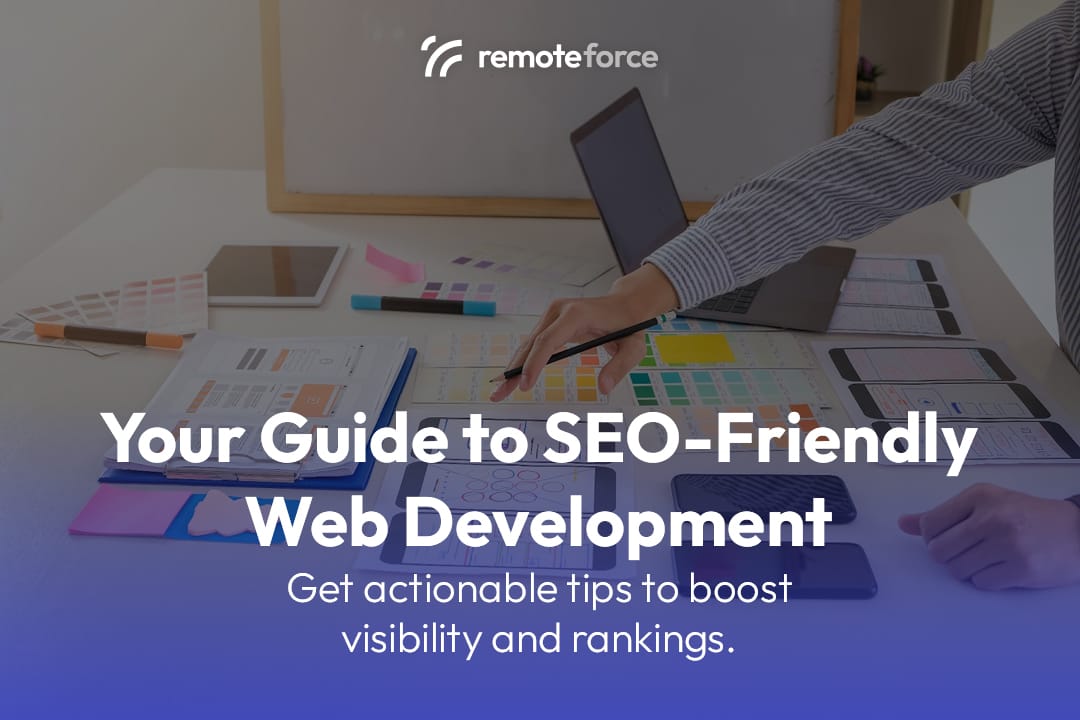In today’s digital age, having a website isn’t enough; your website needs to be found. For businesses and individuals alike, appearing high in search engine results is crucial for driving traffic, generating leads, and achieving online success. This is where Search Engine Optimization (SEO) comes into play. While many people think of SEO as something you do after a website is built, the truth is that true long-term SEO success begins long before your site goes live – it’s woven into the very fabric of its development.
If you’re planning a new website or considering a major revamp, understanding how to build an SEO-friendly website from the ground up is vital. Integrating SEO best practices into your development process isn’t just a recommendation; it’s a fundamental requirement for boosting visibility and achieving higher rankings in competitive search results. Click for actionable tips that will set your website up for organic success from day one!
Table of Contents
ToggleKey Takeaways
Building an SEO-friendly website is a mandatory, multi-stage process that ensures your digital asset is technically sound, easily discoverable, and aligned with user expectations.
- SEO is the Foundation: Building an SEO-friendly website means integrating optimization principles into the planning and development phase—it must be baked in, not bolted on afterward.
- Three Key Phases: Success relies on a structured approach: Strategic Planning (Keyword Research, Information Architecture), Technical Development (Speed, Mobile-First, Security), and On-Page Optimization (High-Quality Content, Title Tags, Internal Linking).
- Speed and UX are Ranking Factors: Fast loading speed (Core Web Vitals) and a Mobile-First Responsive Design are non-negotiable technical requirements that Google heavily prioritizes.
- IA Guides Crawlers: A well-planned Information Architecture (IA) and robust Internal Linking Structure ensure search engines can easily crawl and understand your site’s content hierarchy. 5. Beyond the Code: While code is crucial, long-term success requires generating High-Quality, Comprehensive Content that genuinely solves the user’s problem.
Why SEO Needs to Be Baked In, Not Bolted On
Think of your website as a house. You wouldn’t build a house and then try to bolt on a strong foundation afterward. Similarly, SEO isn’t an afterthought or a quick fix; it’s the foundation upon which your digital presence stands. Trying to optimize a poorly built website later can be costly, time-consuming, and less effective than incorporating SEO principles from the initial planning and development stages.
Search engines like Google use complex algorithms to crawl, index, and rank websites. These algorithms prioritize sites that are technically sound, provide a great user experience, and offer relevant, high-quality content. By building an SEO-friendly website from scratch, you inherently align your site with what search engines value, setting yourself up for long-term organic growth.
How to Build an SEO-Friendly Website from the Ground Up: Actionable Steps

Let’s explore the critical steps to integrate SEO best practices throughout your website development process.
1. Strategic Planning & Keyword Research (Before Coding Begins)
SEO starts long before any code is written. This foundational phase dictates your site’s structure and content strategy.
- Define Your Target Audience and Goals: Who are you trying to reach? What do you want them to do on your site?
- Comprehensive Keyword Research: Identify the primary and secondary keywords your target audience uses to find information, products, or services like yours. Use tools (e.g., Google Keyword Planner, Ahrefs, SEMrush) to find high-volume, relevant keywords with manageable competition.
- Competitor Analysis: Study the top-ranking websites in your niche. What keywords are they targeting? How is their site structured? What kind of content do they publish? Identify gaps and opportunities to create something better.
- Information Architecture (IA) Planning: Based on your keyword research, map out your website’s logical structure. How will pages be organized? What will your main categories and subcategories be? This forms the basis of your site map and navigation.
Value-Add: A well-planned IA, driven by keyword research, ensures that your website’s structure naturally aligns with user search queries, making it easier for both users and search engine crawlers to understand your content.
2. Technical SEO Fundamentals (During Development)
These are the backend and structural elements that allow search engines to crawl, understand, and index your website effectively.
- Fast Loading Speed (Core Web Vitals):
- Optimize Images: Compress images, use modern formats (WebP), implement lazy loading.
- Minify Code: Reduce file sizes of HTML, CSS, and JavaScript by removing unnecessary characters.
- Efficient Server Response: Choose a reliable hosting provider and optimize server configurations.
- Prioritize Above-the-Fold Content: Load critical content first.
- Impact: Google heavily emphasizes page speed for ranking and user experience.
- Mobile-First Design and Responsiveness:
- Ensure your website adapts seamlessly to all screen sizes (desktops, tablets, smartphones). Google primarily uses the mobile version of your site for indexing and ranking.
- Impact: A non-responsive site will suffer in mobile search rankings and deter mobile users.
- Clean URL Structure:
- Create short, descriptive, and keyword-rich URLs (e.g.,
yourwebsite.com/services/web-designinstead ofyourwebsite.com/page?id=123). - Use hyphens to separate words.
- Impact: Clear URLs are easier for users to understand and search engines to crawl.
- Create short, descriptive, and keyword-rich URLs (e.g.,
- SSL Certificate (HTTPS):
- Implement HTTPS for security. It encrypts data transferred between the user’s browser and your server.
- Impact: Google uses HTTPS as a ranking signal, and browsers flag non-HTTPS sites as “not secure,” impacting user trust.
- XML Sitemaps:
- Create an XML sitemap (a file listing all the important pages on your site) and submit it to search engines (Google Search Console, Bing Webmaster Tools).
- Impact: Helps search engines discover all your essential pages, especially on large or complex sites.
- Robots.txt File:
- Use a
robots.txtfile to instruct search engine crawlers which pages or sections of your site they should or shouldn’t crawl. - Impact: Prevents search engines from wasting crawl budget on unimportant or duplicate content.
- Use a
- Schema Markup (Structured Data):
- Implement schema markup to provide context to search engines about the content on your pages (e.g., distinguishing a product from a review, an event from a recipe).
- Impact: Can lead to rich snippets (enhanced search results) that improve click-through rates.
Also Read: How SEO Web Development Boosts Your Online Visibility
3. On-Page SEO Essentials (During Content Creation & Page Building)
Once the technical foundation is laid, these elements ensure your content is optimized for specific keywords.
- Keyword Integration: Naturally weave your target keywords into page titles, headings (H1, H2, H3), meta descriptions, and body content.
- High-Quality, Comprehensive Content:
- Create content that thoroughly answers user queries, provides unique value, and is more in-depth and informative than competitors.
- Aim for longer-form content (e.g., 1000+ words for competitive topics) when appropriate.
- Impact: High-quality content is the single most important factor for long-term SEO success.
- Optimized Title Tags and Meta Descriptions:
- Title Tag: The main title of your page, appearing in browser tabs and search results. It should be concise, include your primary keyword, and be compelling (around 50-60 characters).
- Meta Description: A brief summary of your page’s content, displayed under the title in search results. While not a direct ranking factor, a compelling meta description significantly impacts click-through rates (around 150-160 characters).
- Image Optimization:
- Use descriptive file names (e.g.,
blue-widget.jpgnotIMG001.jpg). - Add descriptive
alt textto all images (for accessibility and search engine understanding). - Compress images for faster loading.
- Use descriptive file names (e.g.,
- Internal Linking Structure:
- Link relevant pages within your website using descriptive anchor text (e.g., “learn more about digital marketing strategies“).
- Impact: Helps search engines discover new pages, distributes “link equity” across your site, and guides users through related content.
- User Experience (UX) Focus:
- Ensure easy navigation, clear calls to action, and an intuitive layout.
- Impact: Search engines value user signals (time on site, bounce rate, pages per session). A good UX leads to positive signals, which can indirectly boost rankings.
Sustaining Success: The Importance of Technical SEO Audits
The article covers the initial build, but a website’s technical health degrades over time due to content additions, plugin updates, or external changes. Continuous Technical SEO Auditing is essential to sustain high rankings and visibility.
Why Continuous Auditing is Necessary
A site is a dynamic entity, not a static brochure. Without proactive checks, issues arise that impede crawling and ranking:
- Crawl Decay: New broken links, incorrect canonical tags, or accidentally blocked sections in robots.txt.
- Speed Regression: New plugins, larger images, or inefficient third-party scripts can secretly slow the site down, negatively impacting Core Web Vitals.
- Google Algorithm Updates: Search engine updates often introduce new technical requirements (like INP replacing FID), requiring developers to adapt.
Key Areas for the Quarterly Audit
A full technical audit should be performed at least every quarter, focusing on:
- Crawl Error Analysis: Checking Google Search Console for “Not Found” (404) or “Server Error” (5xx) responses and fixing or redirecting them.
- Site Speed Health Check: Re-running Core Web Vitals diagnostics to ensure LCP, INP, and CLS scores remain in the “Good” range.
- Indexability Review: Verifying that critical pages are indexed and non-critical pages (like privacy policy) are correctly disallowed or tagged as noindex, follow.
- Internal Link Integrity: Scanning the site for broken internal links and orphaned pages (pages with no internal links pointing to them).
Using Google Search Console (GSC) for Maintenance
GSC is a free, essential SEO tool provided by Google that acts as the website’s technical health dashboard. Regular maintenance should include:
- Monitoring the Performance Report for declining clicks/impressions.
- Checking the Coverage Report for indexing errors.
Reviewing the Core Web Vitals Report for real-world user speed data.
Conclusion: Laying the Groundwork for Digital Dominance
How to build an SEO-friendly website from the ground up? It means embracing SEO as an integral part of your web development process, not an afterthought.
By meticulously planning your site’s structure based on keyword research, implementing robust technical SEO fundamentals, and crafting high-quality, optimized content, you create a powerful digital asset that is inherently aligned with search engine algorithms and user expectations.
This proactive approach lays the strongest possible groundwork for superior visibility, sustained organic traffic, and ultimately, significant business growth in the competitive online landscape.
If you’re ready to launch a website that’s not just visually appealing but also engineered for top search engine performance, partnering with SEO-aware web development experts is crucial.
At RemoteForce, we specialize in comprehensive web and app development services that integrate SEO best practices from the very first wireframe. Our team understands that a beautiful website is only effective if it can be found.
We build fast, secure, responsive, and search-engine-optimized websites designed to rank high, attract your target audience, and convert visitors into loyal customers. Beyond web and app development, RemoteForce also offers digital marketing, graphic design, secretarial, legal, and accounting services, providing a holistic suite of solutions to empower your entire business.
Ready to build a website that’s optimized for both users and search engines? Contact RemoteForce today to start your SEO-friendly web development project!
Frequently Asked Questions (FAQ)
1. What is “Crawl Budget” and why should I care?
Crawl Budget is the amount of time and resources Google’s robot (Googlebot) is willing to spend crawling your website within a given period. For large sites (thousands of pages), wasting the budget on low-value pages (like old disused tags or thank you pages) can prevent Google from crawling and indexing your newest, most important content.
2. How often should I update or resubmit my XML sitemap?
You should update your XML sitemap every time you add, remove, or significantly modify content on your website. After updating the sitemap, it is best practice to submit the new version to Google via the Google Search Console to promptly inform the search engine of changes.
3. Does a custom-coded site automatically outperform a site built with a CMS like WordPress?
Not necessarily. While a custom-coded site, when built perfectly by an expert developer, can potentially be faster (less bloated code), a well-maintained site on an optimized CMS like WordPress offers far superior Content Management, Plugin Functionality, and Ease of Ongoing SEO Maintenance. For most businesses, the continuous benefit of an accessible CMS outweighs the marginal speed gain of pure custom code.
4. Can I still use an effective SEO strategy if my site is not mobile-responsive?
No. Since Google switched to Mobile-First Indexing, they primarily use the mobile version of your site for ranking calculation. If your site is not mobile-responsive (i.e., it looks poor or is unusable on a phone), your rankings on both mobile and desktop search results will suffer significantly. Mobile responsiveness is now a mandatory baseline for SEO success.




